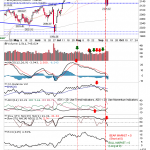 Image Source: PixabayThe bond market seems convinced that interest rates are headed lower for now. The chart (source) below shows the price action for TLT (iShares Long-term Treasury Bond ETF) over the past seven days…
Image Source: PixabayThe bond market seems convinced that interest rates are headed lower for now. The chart (source) below shows the price action for TLT (iShares Long-term Treasury Bond ETF) over the past seven days…
Of particular note is the fact that the succession of higher opening prices left a series of gaps on the chart. Friday’s gap is the largest so far. Also, the total increase in price from Thursday’s close amounted to more than 3%, and accounts for one-third of the entire seven-day advance.OTHER MARKETSOther markets did not fare so well; particularly stocks, which sold off in aggressive fashion on Thursday and Friday. The Nasdaq Composite Index lost 6.7%, while the S&P 500 and DJIA were both down about 4 1/2%. This stands in stark contrast to the sharp increase in Treasury bonds. See charts for all three stock indexes below…
INCREASE IN VOLATILITY Oxford Languages defines volatility as “liability to change rapidly and unpredictably, especially for the worse.” People tend to focus more on “especially for the worse” when referencing volatility; however, the past two trading days in all markets have highlighted that “rapidly and unpredictability” might be more descriptive and accurate.In addition to the volatility evidenced in both stocks and bonds, there was a better example on display in the metals markets. In early morning trade spot gold was priced as high as $2478 oz., $32 higher than where it closed the day before. Then, in the space of one hour, the gold price dropped $70 oz. to $2408. Over the course of trading gold rebounded and closed at $2443, down a negligible $3 oz.Silver’s price action was even more rapid and unpredictable. After rising to a daily high of $29.30 oz, which was up $.84 over its previous close, the white metal dropped nearly 5% ($1.40 oz) during the space of one hour. The daily low was $27.90. Afterwards, the price rebounded to close just a few cents above its prior day’s closing price.Here are charts for both GLD (SPDR Gold Shares ETF) and SLV (iShares Silver Trust ETF) for the same time period shown in bonds and stocks above…
CONCLUSION As we said last week: “Rate cut or not, what happens after will not be as expected or intended.” There has been no announcement yet, but the bond market is acting as if it is a done deal. It is possible that stocks are selling off under a similar presumption. Here is why…Most investors drove stock prices higher in anticipation of rate cuts in the near term, expecting that lower rates would trigger additional economic growth and lead to capital expansion and higher stock prices. Unfortunately, the effects of a potential rate cut are already accounted for in current stock prices. The highly anticipated announcement isn’t likely to have much positive impact on stock prices and could actually trigger more selling. Also, the rapidly weakening economy could override any possible stimulus from the cut(s).Meanwhile, volatility, i.e., the liablility to change rapidly and unpredictably, especially for the worse, can be expected to increase in all markets.More By This Author:What Happens After A Rate Cut Is Announced?
And So Rates Will Be Higher
Descending Price Peaks In Latest Gold Charts








Leave A Comment